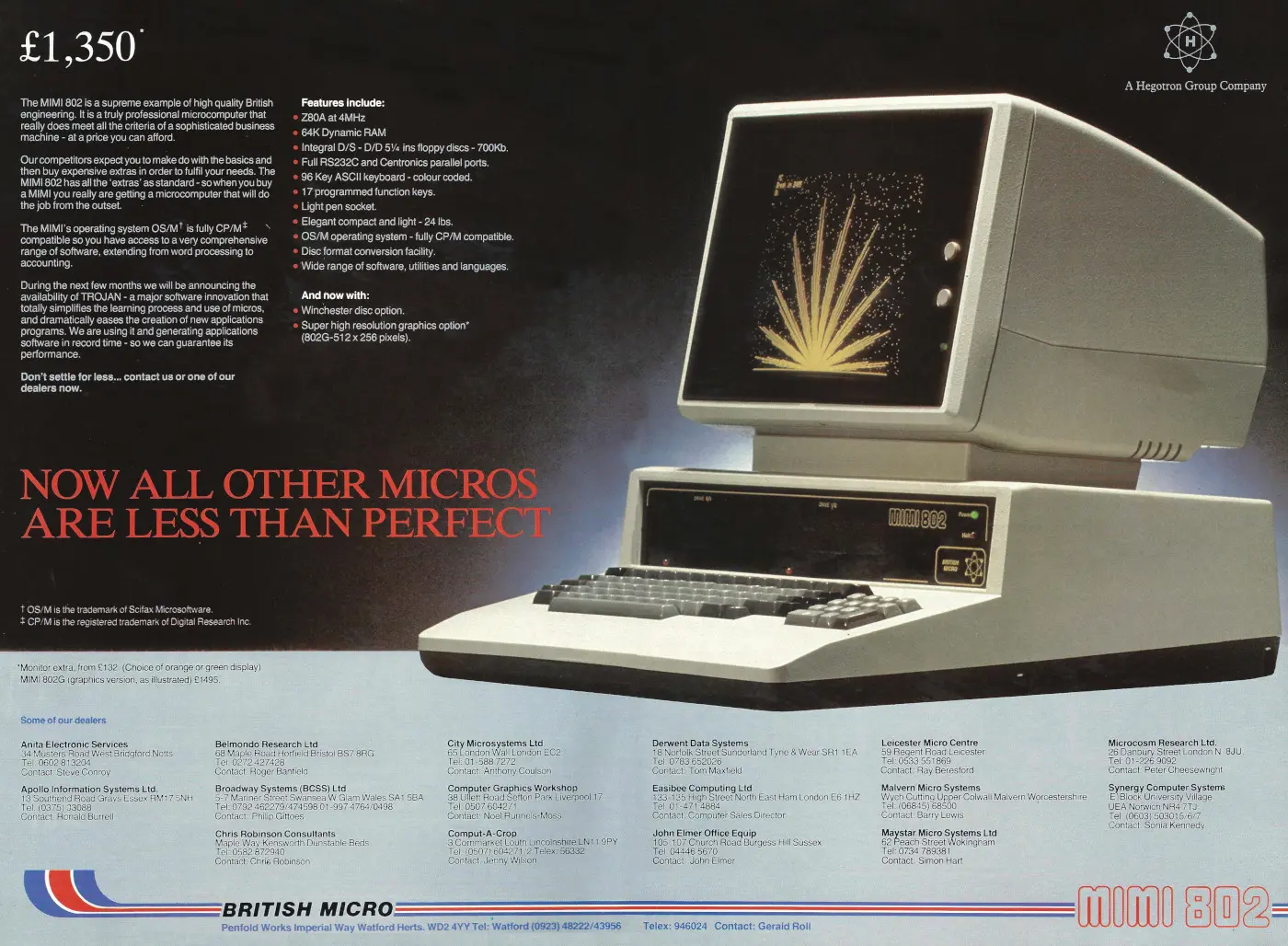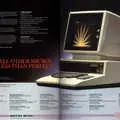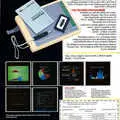
British Micro Advert - December 1982
From Personal Computer World

British Micro: Now Other Micros Are Less Than Perfect
At first sight this is another obscure entry in the who/what/where department, however British Micro was connected to the more famous Nascom and Gemini Microcomputer, both founded by John Marshall.
The connection between the two came via Manas Heghoyan, owner of a Watford-based PCB manufacturing company - Hegotron Printed Circuit Boards Ltd - who had previously attempted to buy Nascom after it had gone bust in 1980.
That attempt failed, however Heghoyan was still keen on entering the microcomputer industry and so after discussing ideas with Marshall - who he had met following the Nascom buy-out talks and who had already founded Gemini - started his own company instead.
Heghoyan named his burgeoning empire The Hegotron Group and set up the British Micro operation at Penfold Works in Watford, where his old PCB company had been based.
The company's Mimi 802 - the name was said to be that of Heghoyan's daughter - was a OS/M-running (fully CP/M compatible) Z80A-based micro with 64K memory and was first released in 1981[1].
It was an update to the previous Gemini 801/Mimi 801, both of which were designed by Gemini Micro[2] - a company which had also evolved out of Nascom.
The Gemini GM801 had been launched at Compec '80, but had been modified to become British Micro's first machine, where it was known as the Mimi 801. John Marshall said of the original launch, as reported in December 1981's Practical Computing, that:
"When we launched the Gemini at Compec, we anticipated total orders of about 20 per month, which was well within our capacity. I was soon disabused of this idea when advanced orders exceeded 200 a month. In-house production plans were shelved while I investigated potential backers. This was a fortuitous respite because we discovered that the computer-drawn artwork for the main board was full of bugs. It has now been manually artworked as is perfect. About three months ago I met Manas, following the setback of his plan to buy my old company, Nascom Microcomputers - now owned by Lucas. Fortunately he was still interested in acquiring an interest in microcomputers and our discussions have led to the official launch of British Microcomputers[3]".
The Gemini 802, named by British Micro as the Mimi 802, was also said to be something of a "spiritual successor" to Intertec's seemingly-omnipresent SuperBrain micro[4], and could directly read SuperBrain floppy disks.
Its overall design also owes a debt to 1977's Commodore PET, with a similar off-white upper and black lower case construction and a monitor with a black bezel perched on the top, although the material of manufacture has moved on from the PET's steel to plastic.
Such was its design that the Mimi was even featured in a six-week-long display at the London and Glasgow Design Centres[5].
It had integral 700K Pertec double-sided double-density floppy disk drives with a colour-coded 96-key keyboard and at 24lbs (a little over 10kg) in weight, was apparently "compact and light".
The advert also announced the availability of "Trojan", developed by software company Scifax.
This was one of a few program-generating languages around at the time, and was due for release as soon as the manual had been completed, which was thought to the the end of summer 1983.
The company's first home-grown software - Trojan Sales Ledger and Trojan Purchase Ledger - was released in May, with Nominal Ledger due a month later.
Trojan retailed for £250 (about £1,100 in 2025) and supplemented the existing Cashfix spreadsheet, released in April and which sold for £120 (about £530)[6].
Trojan re-appeared a couple of years later on the IBM PC. Still developed by Scifax, which had since been taken over by media mega-corp BMG, the price of Trojan had doubled from its previous Mimi price of £250 to around £500. MD of Scifax Howard Lock-Hooper said that:
"we've added more applications including Bought Ledger, Word Processing, Stock Control and Video-tape hire management. But the real reason for the price difference is that as part of BMG we feel we ought to give our partners a boost"[7].
At £1,350, or around £5,960 in 2025 money, the Mimi 802 was firmly in the "professional" price bracket, not least as the orange- or green-screen monitor was an extra £132, or about £580 in 2025.
However, being from a UK manufacturer meant that it could have gone into the educational market, where the price was actually cheaper than Research Machines' 380Z. There were apparently 12 already installed in the University of Nottingham.
The Mimi 801 had already been released in Denmark, The Netherlands and France, and had even been shipped to South Africa, Greece and Iceland, with some orders from West Germany. The company was expecting to sell 2,500 units during 1982.
That's small beer for a company like Commodore, but still a reasonable trade.
Mike Curtis concluded in his benchtest/review of the Mimi 801 in July 1982's Personal Computer World that:
"It deserves to succeed even if I might query the wisdom of jumping in at the deep-end in what is simultaneously the most competitive section of the market and the one that could well show the greatest upheaval in the near future as new processors and operating systems challenge the Z80 and CP/M stranglehold. I liked the Mimi and it created a very favourable impression whilst sitting on my desk; it is a good-looking, well engineered, professional system[8]".
Date created: 13 February 2013
Last updated: 28 July 2025
Hint: use left and right cursor keys to navigate between adverts.
Sources
Text and otherwise-uncredited photos © nosher.net 2025. Dollar/GBP conversions, where used, assume $1.50 to £1. "Now" prices are calculated dynamically using average RPI per year.

